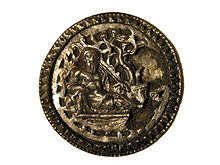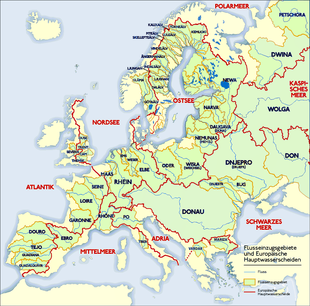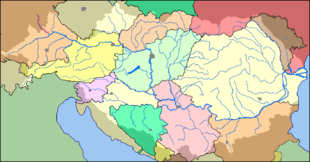Danube
![]()
The title of this article is ambiguous. For other meanings, see Danube (disambiguation).
With an average water flow of around 6855 m³/s and a total length of 2857 kilometres, the Danube is the second largest and second longest river in Europe after the Volga. The river drains large parts of Central and Southeastern Europe. It flows through or touches ten countries (Germany, Austria, Slovakia, Hungary, Croatia, Serbia, Bulgaria, Romania, Moldova and Ukraine) - more than any other river on earth.
The Danube takes its name from the confluence of two headwaters, the Brigach and the larger Breg, both of which rise in the central Black Forest. It crosses three large basin landscapes: the northern Alpine foothills and the Vienna Basin (upper reaches), the Pannonian Plain (middle reaches) and the Wallachian Plain (lower reaches). It cuts through the dividing mountains in narrow valleys, the best-known sections of which are the Danube breakthrough at Beuron, the Wachau, the Hainburg Gate (also known as the Pressburg Gate) and the Iron Gate. The river flows into the Black Sea via the extensive Danube Delta.
The Danube is one of the oldest and most important European trade routes and connects different cultures. Political tensions and wars repeatedly caused closures and obstructions of the waterway. Since the fall of the Iron Curtain, the Danube has regained its economic importance. The river connects many species-rich and unspoilt natural areas and is an important location for hydroelectric power plants.
.jpg)
Danube at high water (Beuron)
Names and etymology
The Danube, like most rivers in the German-speaking world, has a feminine name. In Middle High German it was called diu Tuonowe (early New High German Tonaw, Donaw). The root word -ouwe ('river floodplain, -landscape') of its Old High German compound name may have contributed to the feminine gender of today.
All modern names of the river - including Romanian Dunărea, Bulgarian, Serbian, and Croatian Dunav, Slovenian Donava, Hungarian Duna, Turkish Tuna, and Slovak, Russian, Polish, Czech, and Ukrainian Dunaj - derive first from the name Dānuvius of Roman times (with the river god of the same name), but go back to older roots. Danube, like the river names Dnepr, Dnister, Donets, and Don, is possibly Iranian or Celtic in origin. The names could be derived from the Iranian-speaking Scythians and Sarmatians as well as from the Celts of Eastern Europe. An exact linguistic assignment is difficult, since both tribes reached the Danube and the Danube, furthermore both Celtic and Iranian are Indo-European languages and therefore the word "river" in Old Iranian (cf. Avestan dānu, Ossetian don) and Celtic (cf. Welsh Donwy) goes back to the same Indo-European root *dʰenh₂- 'to flow'. In the Celtic language family, this is said to go back to the goddess Danu (also Danann).
In ancient times, the Danube had two names for a long time: Ister or Hister, in ancient Greek Ístros (Ἴστρος), was a name for the lower course, Danube was called only the upper course. Some Roman cities on the lower reaches of the Danube bore the suffix ad Istrum - for example, Nicopolis ad Istrum. This word stands to a general Indo-European hydronym *heisr- 'fast, hurtig' and is also traced back to the Celtic words ys 'fast, tearing' and ura 'water, river'. According to another interpretation, ys also stands for 'high, low' and thus, like the Latin altus, denotes both aspects of the vertical. In the area of the former Celtic settlement area, besides the old names of the Danube, a number of other names for other rivers are derived from this stem:
- Eisack (South Tyrol, Italy)
- IJssel (Netherlands)
- Isar (Germany)
- Isel (Austria)
- Isère (France)
- Iskar (Bulgaria)
- Jizera (Czech Republic)
- Yser (Belgium)
Hans Bahlow attributed the root sound *is- with the roots *es-, *as-, *os, *us- or *aus- (all supposedly 'marsh/moor water'). Another interpretation assumes a hypothetical Indo-European root *es or *is, interpreted as a generic name for '(flowing) water'.
It was not until the turn of the century, when the Roman Empire had expanded over the entire course of the Danube and the cartographic connections were developed, that the unity of both sections of the river was recognized. Even until the end of antiquity, Ister was a common name for the river, while Dānuvius tended to refer only to the upper reaches. Since the Danube rises in the Black Forest and flows into the Black Sea, it is sometimes jokingly referred to as the Black River.

Disc brooch with depiction of the river god Dānuvius, 150-250 AD (Roman Museum Vienna).
Catchment area
Geography and water flow
The Danube catchment area covers about 817,000 square kilometres. It is somewhat asymmetrical; 56 percent of the area lies on the left (north) side of the Danube, 44 percent on the right. Nevertheless, the tributaries of the smaller right side contribute about two thirds of the water volume, which is due to the larger area of high mountains here, which also intercept a large part of the moisture brought in by west and southwest winds.
This is reflected in the fact that in the southern Pannonian basin the Sava, by far the most water-rich tributary, flows in from the right and the Tisza, barely half as large, the longest tributary of the Danube, flows in from the left. Further downstream, the water flow of the Morava, which comes from the right, exceeds that of the Pruth, which comes from the left at the Danube delta and is about five times as long, by a good factor of two. And even in the German Danube basin, the three largest left tributaries (Altmühl, Naab and Regen) together carry less water than the right tributary Lech, which is only the third largest in this part. By far the largest tributary of the upper Danube, the Inn, is at least equal to the Danube at its confluence in Passau, and at Ulm the Danube is even surpassed by the Iller by a good third.
Most of the larger tributaries originate in the Eastern Alps and Carpathians, as well as in the mountains of the Balkan Peninsula. The Carpathians are not a mountain range bordering the Danube basin, but protrude into it because they are drained on the east side by the Siret/Prut system. They separate the lower Danube basin from the middle one. The Alps, with their north-eastern foothills, also jump in and divide the middle and upper Danube.
Source Flows
At Donaueschingen, the Brigach and Breg rivers flow together to form the Danube. Of the two headwaters, the Breg, which rises somewhat further south and higher, is the somewhat larger river according to all hydrological characteristics. In addition, the source pot of the Danube brook near the union of the two headwaters is traditionally considered the source of the Danube. From here, the Danube has a length of a good 2810 kilometres.
Tributaries
→ Main article: List of tributaries of the Danube
The rivers Tisza, Prut, Sava, Drava, Olt, Sereth and Inn each have a length of over 500 kilometres. Rivers with a water flow of over 500 m³/s are Sava, Tisza, Inn and Drava.
| Tributaries of the Danube with more than 140 kilometres of river length | |||||
| Tributary | at km | Page | Length | Discharge | Comments |
| Iller | 2587,9 | R | 147 | 71 | carries more water at the confluence than the Danube |
| Lech | 2496,4 | R | 264 | 114 | |
| Isar | 2281,7 | R | 295 | 175 | |
| Inn | 2225,2 | R | 518 | 738 | at the confluence wider and at times more watery than the Danube |
| Traun | 2125,0 | R | 153 | 135 | |
| Enns | 2111,8 | R | 254 | 195 | |
| Leitha | ≈ 18300, | R | 180 | 10 | flows into the tributary Moson-Danube |
| Raab | 1794,0 | R | 250 | 18 | |
| Kapos | ≈ 14980, | R | 113 | 4,4 | |
| Drava | 1382,5 | R | 749 | 670 | |
| Save | ≈ 11700, | R | 945 | 1722 | most water-rich tributary of the Danube and longest from right |
| Morava | 1104,5 | R | 185 | 255 | |
| Timok | 845,7 | R | 203 | 24 | |
| Iskar | 637,0 | R | 368 | 54 | |
| Jantra | 536,7 | R | 285 | 47 | |
| Altmühl | 2411,6 | L | 220 | 16 | |
| Naab | 2385,3 | L | 165 | 50 | |
| Rain | 2379,2 | L | 169 | 40 | |
| Kamp | ≈ 19850, | L | 153 | 9 | |
| March | 1880,3 | L | 358 | 109 | |
| Waag | 1765,8 | L | 403 | 152 | |
| Hron | 1716,0 | L | 298 | 55 | |
| Ipeľ | 1708,2 | L | 233 | 21 | |
| Tisza | 1214,5 | L | 1308 | 813 | longest tributary of the Danube |
| Temesch | ≈ 11500, | L | 340 | 47 | |
| Jiu | 691,6 | L | 331 | 94 | |
| Olt | 600,6 | L | 737 | 190 | |
| Vedea | ≈ 5300, | L | 224 | 12 | |
| Argeș | 432,0 | L | 327 | 73 | |
| Ialomița | 231,1 | L | 417 | 40 | |
| Sereth | 155,1 | L | 596 | 230 | |
| Pruth | 134,1 | L | 953 | 110 | |
Islands
→ Main article: List of Danube islands
The Danube has numerous larger and smaller islands. The best known include the Upper and Lower Wöhrd in Regensburg, the Jochenstein, the Danube Island in Vienna, the Great Schütt Island, Margaret Island in Budapest, the Great War Island near Belgrade and the Balta Ialomiței in Romania.

List of tributaries taken from the Handbuch für Donaureisen, Vienna 1935, published by the Erste Donau-Dampfschiffahrts-Gesellschaft (First Danube Steamship Company)

River basins and main watersheds in Europe

Catchment area and main tributaries of the Danube
Questions and Answers
Q: What is the second longest river in Europe?
A: The Danube (Latin name Hister) is the second-longest river in Europe.
Q: How long is the Danube River?
A: The Danube River is 2,860 km (1,777 mi) long.
Q: Where does the Danube begin and end?
A: The Danube begins at Brigach and Breg joining together in Donaueschingen near the Black Forest and ends at the Black Sea through the Danube Delta.
Q: What countries does it flow through or make part of their border?
A: The Danube flows through or makes part of the border of 10 countries including Germany, Austria, Slovakia, Hungary, Croatia, Serbia, Romania, Bulgaria, Moldova and Ukraine.
Q: What are some bigger cities located on its banks?
A: Bigger cities located on its banks include Ulm and Regensburg in Germany; Linz and Vienna in Austria; Bratislava in Slovakia; Budapest in Hungary; Vukovar in Croatia; Novi Sad and Belgrade in Serbia.
Q: Are there any artificial waterways built on it?
A: Yes, there are three artificial waterways built on the Danube.
Q: How far upriver can ocean ships travel on it? A: Ocean ships can go up to Brăila in Romania.
Search within the encyclopedia